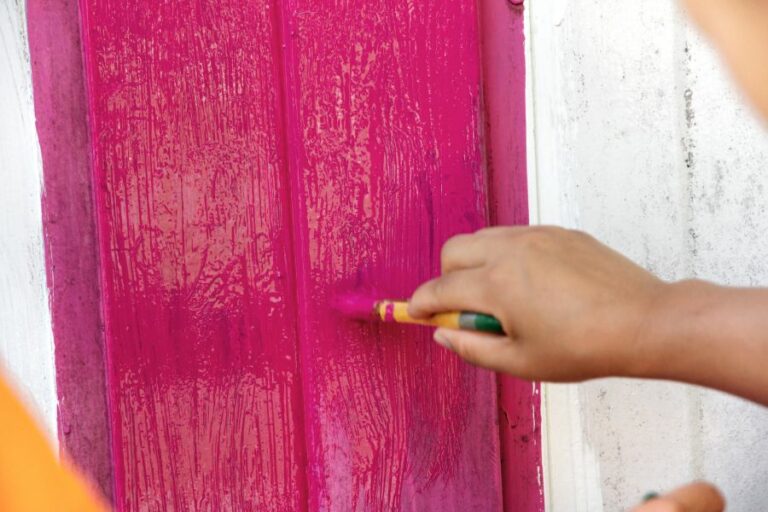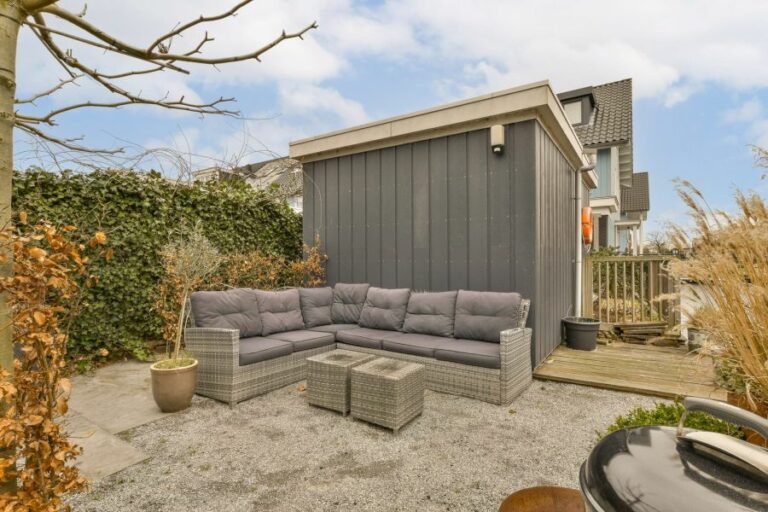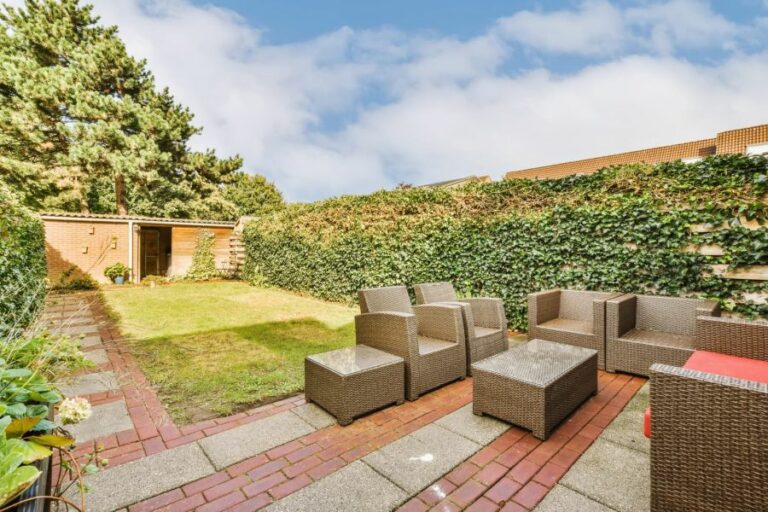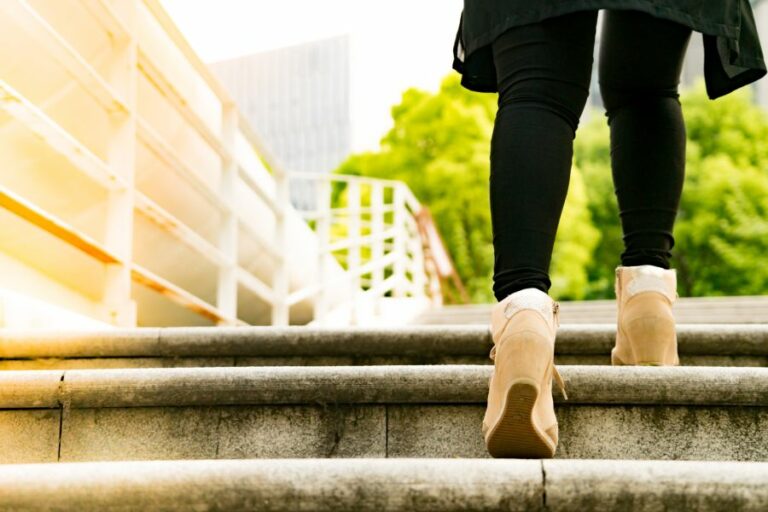Outdoor Cinder Block Wall Paint Ideas, 25 Things You Should Know
Breathe new life into your otherwise dull and monotonous concrete walls by exploring various colors, patterns, and textures that can elevate your space’s aesthetic appeal. Say goodbye to boring walls and discover an array of unique designs that can transform your outdoor living areas into vibrant and welcoming places where you’ll love spending time.
Outdoor cinder block wall paint ideas:
Transform your outdoor cinder block wall with creative paint ideas and techniques, such as geometric patterns, stencils and murals, faux brick, color blocking, and textured paint. Choose durable acrylic or masonry paint for outdoor use, and ensure proper preparation, including cleaning, repairing cracks, priming, and sealing. Invest in high-quality materials, use even strokes, and adhere to the manufacturer’s drying time recommendations for a professional and long-lasting result.

Explore various paint ideas and techniques that effortlessly transform your outdoor cinder block walls into stunning art pieces. Discover waterproofing tips, suitable materials, and innovative styles to suit your home’s aesthetic and enhance your outdoor living experience. Let creativity shine!
Contents
- 1 Creative Paint Ideas for Outdoor Cinder Block Walls
- 2 What is the Most Suitable and Effective Paint for Exterior Cinder Block Walls?
- 3 Final Thoughts
- 4 What Type of Paint is Suitable for Outdoor Cinder Block Surfaces?
- 5 What color would be appropriate for painting my cinder block wall?
- 6 How can you enhance the appearance of an outdoor cinder block wall?
Creative Paint Ideas for Outdoor Cinder Block Walls
A cinder block wall can be an unattractive and boring part of your outdoor space. However, with the right paint and ideas, you can easily transform it into an eye-catching and dynamic feature.
• Choosing the Right Paint for Your Cinder Block Wall
Before diving into the exciting world of paint ideas, picking the right type of paint for your cinder block wall is essential. Not all paints are suitable for outdoor use or for covering porous surfaces like cinder blocks.
– Acrylic Paints
I highly recommend using acrylic paints for your cinder block wall. They are water-based, durable, and can be easily applied to various surfaces, including concrete and masonry. Acrylic paints are also resistant to weather conditions, UV rays, and mildew, ensuring a long-lasting finish.
– Masonry Paints
Another excellent option for cinder block walls is masonry paint. These paints are specifically designed for use on masonry surfaces, providing excellent coverage and adhesion. Moreover, masonry paints have a high resistance to water, making them perfect for outdoor use.
• Preparing Your Cinder Block Wall for Painting
Proper preparation is crucial for achieving a professional-looking result that will stand the test of time. Therefore, ensure that you:
- Clean the wall: Remove dirt, debris, and any loose or flaking paint using a wire brush or power washer. This step will help the paint adhere properly and provide a smooth finish.
- Repair any gaps or holes: Fill gaps or cracks in the wall with an appropriate filler or patching compound, following the manufacturer’s instructions. This will help prevent moisture from getting into the wall and causing damage.
- Apply a primer: A good-quality masonry primer is essential for creating a solid base for your paint. It will help improve adhesion, address any potential issues with the surface, and ensure better coverage.
• Creative Paint Ideas for Your Outdoor Cinder Block Wall
Now that your cinder block wall is properly prepped, it’s time to explore some creative paint ideas to spruce up your outdoor space.
– Geometric Patterns
Adding geometric patterns to your cinder block wall can give it a modern and contemporary look. Some ideas include painting bold stripes, chevrons, or diamond shapes in contrasting colors. Masking tape can create sharp, clean edges and achieve a polished look.
– Stencils and Murals
Using stencils or painting a mural is a great way to add interest and personalization to your cinder block wall. The possibilities are endless, from floral patterns to abstract designs or even a scene from nature. Be sure to use the appropriate paint and sealant to protect your artwork from the elements.
– Faux Brick or Stone
If you’d like your cinder block wall to resemble a brick or stone surface, you can achieve this look by using paint to create a faux finish. There are several techniques for creating this effect, such as sponging, dragging, or dry brushing. You can also use a brick or stone stencil to help achieve a realistic appearance.
– Color Blocking
Color blocking is a simple yet impactful way to add visual interest to your cinder block wall. Choose two or more complementary or contrasting colors and paint large sections or shapes in each color. The result will be a bold and modern look that draws the eye.
– Textured Paint
Textured paint can add depth and character to your cinder block wall while also helping to mask any imperfections. Various types of textured paint are available, from granular to smooth finish, providing several options to create a unique look.
• Tips for a Professional Finish
To ensure a top-notch result, follow these tips:
- Choose high-quality materials: Invest in premium paints, brushes, and other painting supplies to achieve a long-lasting, professional finish.
- Work in even strokes: Maintain a steady hand and use even strokes when painting for a smooth and blemish-free result.
- Allow proper drying time: Follow the manufacturer’s recommendations for drying times between coats to avoid potential issues, such as peeling or cracking.
- Seal your painted wall: Protect your freshly painted cinder block wall by applying a clear sealer, ensuring that it is suitable for outdoor use and compatible with the type of paint you use.
In conclusion, painting your outdoor cinder block wall can significantly enhance its appearance and your overall outdoor space. You can turn an ordinary cinder block wall into a stunning focal point with the right paint, preparation, and creative ideas.
So, unleash your creativity and give your wall the makeover it deserves.
Idea | Description | Benefits |
|---|---|---|
Murals | Paint an artistic mural or design on your cinder block wall. | Adds a unique and creative element to your outdoor space. |
Color Blocking | Paint cinder blocks in alternating colors for a fun and modern look. | Creation of a visually dynamic feature wall and easy customization with various color options. |
Geometric Patterns | Use tape to create geometric shapes and paint them in different, complementing colors. | Adds a clean, modern look to your outdoor wall; easily customizable pattern options. |
Stencils | Use stencils to create a repeating pattern on your cinder block wall. | Provides a classic patterned appearance; use different stencil designs for a unique look |
Faux Brick or Stone | Use paint and/or texturing techniques to create the illusion of brick or stone on your cinder block wall. | Adds a more natural, classic look; can be customized to match the color palette of your outdoor space |
What is the Most Suitable and Effective Paint for Exterior Cinder Block Walls?
Cinder block walls are known for their durability and sturdiness. However, they can still become vulnerable to the elements and deteriorate over time without adequate protection.
Painting your outdoor cinder block wall is a good way to enhance its appearance and provides a protective layer against the harshness of weather conditions.
• Choosing the Right Paint
Many types of paint are available on the market today, each with its unique set of characteristics. Since outdoor cinder block walls are constantly exposed to different weather elements, choosing a paint that offers the necessary protection against such conditions is essential.
– Acrylic Latex Paint
I highly recommend acrylic latex paint for outdoor cinder block walls. This paint sinks into the porous surface of the cinder block, creating a strong and durable bond. It offers excellent resistance to water or moisture, making it perfect for protecting your walls from rain, humidity, or even mold and mildew.
Additionally, acrylic latex paint is known for its longevity and color retention, so you can expect the paint job to last for a long time.
– Elastomeric Paint
Elastomeric paint is another excellent option for outdoor cinder block walls. This paint is a heavy-duty, elastic, and waterproof coating specifically designed for exterior surfaces. It is capable of bridging minor cracks and gaps, providing a continuous protective layer on your wall.
It also boasts excellent durability and weather resistance, ensuring that your cinder block wall stays protected from the elements year-round.
– Masonry Paint
Masonry paint, also known as mineral paint, is a silicate-based paint that offers a breathable and waterproof finish. While not as common as acrylic latex or elastomeric paint, it is ideally suited for cinder block walls in humid and damp climates.
This paint is highly resistant to mold and mildew, making it an excellent choice for outdoor cinder block walls that are prone to these issues.
• Preparing the Cinder Block Wall for Painting
To achieve the best results when painting your outdoor cinder block wall, thoroughly preparing the surface is essential. Taking the time to clean and prime your wall will ensure that the paint adheres properly and lasts longer.
– Cleaning the Wall
Before painting, it is crucial to clean the wall to remove dirt, debris, and efflorescence. Use a pressure washer or a solution of water and a mild detergent to clean the surface. Allow the wall to dry completely before proceeding to the next step.
– Priming the Wall
Once the cinder block wall is clean and dry, applying a good-quality primer is essential. A masonry primer or block filler primer is highly recommended, as it will adequately seal the porous surface of the cinder block and increase paint adhesion.
Allow the primer to dry according to the manufacturer’s directions before applying the paint.
• Tips for Painting an Outdoor Cinder Block Wall
Now that you’re ready to apply the paint, consider these tips to achieve a professional-looking result:
- Select the right tools for your chosen specific paint type, such as a paintbrush, roller, or paint sprayer.
- Apply the paint in thin, even coats, allowing each coat to dry before adding the next.
- Paint in a systematic manner, working on one section at a time to ensure that the entire surface gets coated uniformly.
- Be mindful of humidity and temperature when painting, as extreme conditions, might affect the paint’s drying process and overall adhesion.
- Allow the paint to dry fully before exposing the wall to moisture to ensure that it cures adequately.
• Maintaining Your Painted Cinder Block Wall
Regular maintenance is key to keeping your painted outdoor cinder block wall looking its best. Be sure to clean the wall at least once a year to remove accumulated dirt, dust, and debris.
Perform regular inspections and touch up any areas that show signs of wear or damage to keep the wall’s protective layer intact.
Final Thoughts
In conclusion, the best paint for outdoor cinder block walls is acrylic latex, elastomeric, or masonry paint. Each type offers excellent protection against the elements and can help prolong the life of your cinder block wall.
Preparing the wall before painting, choosing the right paint and tools, and providing regular maintenance are all essential steps in achieving and maintaining a beautiful and durable paint job.
What Type of Paint is Suitable for Outdoor Cinder Block Surfaces?
Cinder block walls are a common feature in many homes and commercial buildings. They offer durability and strength, but when it comes to aesthetics, they can often look dull and unattractive. One way to enhance the appearance of your outdoor cinder block wall is by applying paint.
Painting cinder blocks provides a fresh, new look and acts as a protective barrier against the elements. However, selecting the right type of paint for your outdoor cinder block wall is essential.
• Understanding the Surface of Cinder Blocks
Before diving into the types of paints available, it’s essential to understand the unique characteristics of cinder block surfaces. Cinder blocks are made from a mixture of cement, sand, and water, which creates a porous surface.
his porous nature allows moisture to penetrate the cinder block, making the surface prone to water damage, cracking, and mold growth.
Considering these factors, look for a paint that offers excellent adhesion, durability, and resistance to moisture and mildew. These qualities will ensure that the paint job lasts many years.
• Types of Paint for Outdoor Cinder Block Walls
– Masonry Paint
Masonry paint is specifically designed for use on masonry surfaces, such as cinder blocks, bricks, and concrete. It is a water-based paint that contains acrylic or latex resins, which gives it excellent durability, flexibility, and adhesion properties.
Masonry paint is an ideal choice for outdoor cinder block walls for several reasons:
- Excellent resistance to moisture and mildew due to its special formulation
- Stands up well against harsh weather conditions
- Adheres well to porous surfaces
- Allows the cinder block walls to breathe, preventing moisture buildup
I recommend you choose masonry paint with a satin or semi-gloss finish, as these finishes are better suited to withstand exposure to the elements and allow for easier cleaning.
– Elastomeric Paint
Another excellent option for outdoor cinder block walls is elastomeric paint. This type of paint contains high-quality resins that create a rubber-like, flexible coating on the surface, making it resistant to water, cracks, and extreme weather conditions.
Elastomeric paint is particularly suitable for cinder block walls that might have minor cracks or uneven surfaces, as it effectively fills and seals these imperfections. Some benefits of using elastomeric paint on cinder block walls include:
- Provides an extremely durable and weather-resistant finish
- Excellent adhesion to porous surfaces
- Fills and seals minor cracks and surface imperfections
- Prevents moisture infiltration, which can lead to mold and water damage
However, elastomeric paint is generally more expensive than masonry paint, so you will need to weigh the benefits against the cost to determine if it’s the right choice for your project.
– Concrete Stain
A concrete stain might be a suitable option if you prefer a more natural look for your cinder block wall. Concrete stains are typically water-based and provide a semi-transparent finish that enhances the original color and texture of the cinder block, giving it a more natural, stone-like appearance.
Concrete stains do not provide the same level of protection as masonry and elastomeric paints, but they are resistant to fading, chipping, and peeling. They also allow the cinder block to breathe, reducing the risk of moisture damage.
When selecting a concrete stain for your outdoor cinder block wall, choose a product that is specifically designed for masonry surfaces and rated for outdoor use.
• Preparing the Cinder Block Surface for Painting
Proper surface preparation is crucial for achieving a long-lasting, quality paint job. Before applying paint or stain to your cinder block wall, follow these steps:
- Clean the surface: Remove any dirt, dust, loose mortar, and debris by using a wire brush or pressure washer. Allow the surface to dry completely before moving to the next step.
- Repair any cracks: If there are noticeable cracks in the cinder block, fill them with a masonry crack filler, following the manufacturer’s instructions.
- Apply a masonry primer: For best results, apply a masonry primer to the cinder block surface. This will seal the porous surface and ensure better adhesion for your chosen paint or stain. Allow the primer to dry according to the manufacturer’s recommendations.
• Conclusion
A fresh coat of paint can transform your outdoor cinder block wall and enhance the overall appearance of your property. When selecting paint for your project, consider the specific requirements of your wall, such as exposure to weather, moisture, and surface imperfections.
You can achieve a long-lasting, attractive finish on your outdoor cinder block wall by choosing the right type of paint, following proper surface preparation steps, and applying the product according to the manufacturer’s instructions.
What color would be appropriate for painting my cinder block wall?
A cinder block wall can provide a strong and durable structure for years to come. However, it can also be an eyesore if not properly treated or painted.
• Consider the Purpose of the Space
Before selecting a color, it’s essential to consider the purpose of the space where the cinder block wall is located. This will help you to choose a paint color that complements the room’s function.
– Home Exterior
If you are painting an exterior cinder block wall, selecting a color that complements the rest of your home’s exterior design is essential.
Consider using neutral colors like cream, beige, or light gray for a timeless and classic look. If you prefer a bolder statement, choose a dark gray or navy shade to make the wall stand out.
– Garden or Outdoor Area
When painting a cinder block wall in a garden or outdoor area, opt for colors that blend with the surroundings. Greens, browns, and earthy tones are perfect for creating a natural and harmonious look.
– Basement or Garage
Choose a functional color that won’t show dirt or scuff marks for rooms like basements and garages, where the walls don’t typically require a decorative touch. Light to medium gray shades are ideal for these spaces.
• Determine Your Color Preference
Once you’ve assessed the room’s purpose, it’s time to determine your color preference. Here are some tips to help you choose the right paint color for your cinder block wall:
– Light vs. Dark Colors
Light colors can help brighten a room and create an open, airy atmosphere. They are particularly useful in smaller spaces, as they can make the room feel larger. In contrast, dark colors can create a cozy, intimate feel but may also make a room feel closed-off if not used sparingly.
– Warm vs. Cool Colors
Warm colors, like reds, oranges, and yellows, evoke feelings of warmth and energy. Cool colors, such as blues, greens, and purples, tend to create a calming and soothing environment. Determine the type of atmosphere you want for the space and choose a color matching that desired vibe.
– Vivid vs. Muted Colors
Vivid colors can make a strong statement and provide a focal point for a room, while muted colors can create a more subtle and relaxing environment. Consider the overall look you want when choosing between vivid and muted colors.
• Test Paint Samples
Once you have a general idea of your desired color, testing paint samples on your cinder block wall is essential. This will provide you with an accurate idea of how the color will look against the wall’s texture and in the room’s lighting conditions.
Find at least three different shades close to your chosen color and purchase small sample cans. Apply each shade to a small section of the wall, allowing it to dry before comparing the colors. Viewing the colors in different lighting conditions is essential for making an informed decision.
• Choosing the Right Paint for Cinder Block Walls
Selecting the appropriate type of paint is essential when painting cinder block walls, as not all paint formulations will adhere properly to the surface.
We recommend using high-quality masonry or concrete paint as these products are specifically designed for excellent adhesion and durability on cinder block surfaces.
Additionally, consider applying a primer before painting the wall to ensure better coverage and paint longevity. Priming the surface will also provide a smoother finish, so the end result will be more visually appealing.
• Tips for Painting Your Cinder Block Wall
Here are some helpful tips to ensure a successful and long-lasting paint job on your cinder block wall:
- Clean the wall thoroughly, removing any dirt, dust, or debris.
- Repair any cracks or damage with a concrete filler or sealer.
- Remove any loose or peeling paint with a wire brush if the wall has been previously painted.
- Apply a masonry primer, allowing it to dry according to the manufacturer’s instructions.
- Use a thick-nap roller or masonry brush for even paint coverage.
- Apply at least two coats of paint, allowing each coat to dry fully before adding the next.
By following these tips and carefully selecting the right paint color for your cinder block wall, you will have a beautiful and durable wall that complements your space and serves as a functional and attractive element in your home or outdoor area.
How can you enhance the appearance of an outdoor cinder block wall?
Cinder block walls offer strong and durable structures for different purposes, including retaining walls, building foundations, and privacy fences.
However, they may not be very appealing in terms of aesthetics, as their bland and monotone appearance can make them less attractive than other wall materials.
Luckily, there are multiple ways to enhance the appearance of an outdoor cinder block wall to make it more appealing, giving your space a more cohesive and attractive look.
• 1. Painting the Wall
One of the simplest and most affordable ways to improve the appearance of your cinder block wall is through painting. With the right preparation and choice of paint, you can significantly transform the visual appeal of your wall.
– Preparing the Wall
Before painting a cinder block wall, ensure it’s clean, dry, and free from any cracks or other issues. To clean the wall:
- Use a broom or pressure washer to remove any loose dirt and debris.
- Treat any noticeable mold or mildew with a mixture of bleach and water.
- Fill any cracks with mortar repair compound and let it dry.
– Choosing the Right Paint
Select a paint that is specifically designed for masonry surfaces to ensure good coverage and durability. Here are some tips for choosing the right paint:
- Opt for a high-quality, water-based acrylic paint for best results.
- Choose a color that complements the environment or adjacent building elements.
- Consider using a paint sprayer for an even coat.
– Painting Process
Follow these steps to paint your cinder block wall:
- Apply a coat of masonry primer to the wall with a large brush or roller.
- Let the primer dry completely, according to the manufacturer’s instructions.
- Apply the first coat of paint using a roller or paint sprayer.
- Allow the paint to dry for the recommended time.
- Apply a second coat, and repeat as necessary until you achieve the desired coverage.
• 2. Adding a Stucco Finish
Applying a stucco finish is another method that can significantly enhance the appearance of a cinder block wall. Stucco is a cementitious mixture that can be applied in various textures, offering a more pleasing look.
– Mixing and Applying Stucco
To create a stucco finish, follow these steps:
- Mix the stucco according to the manufacturer’s instructions.
- Dampen the cinder block wall with a hose to help the stucco adhere.
- Apply the stucco mixture to the wall using a trowel or a plasterer’s hawk and trowel.
- Create the desired texture using a trowel or other specialized tools.
– Painting Stucco
Once the stucco finish has dried, you may choose to paint it to provide a more cohesive look to your property. Use the same steps mentioned in the painting section to prepare and paint the stucco surface.
• 3. Installing a Faux Stone or Brick Veneer
Faux stone and brick veneers are decorative surface materials that can be applied to a cinder block wall to create a more visually appealing appearance. These materials are designed to resemble real stone or brick and can provide a natural, textured look.
– Selecting the Veneer Material
Choose a faux stone or brick veneer product that complements the style of your property and adds texture and depth. Ensure the chosen veneer is appropriate for exterior use and is compatible with your cinder block wall.
– Installation Process
The installation process may vary depending on the chosen product. Here are general steps to follow:
- Prepare the wall by ensuring it’s clean, dry, and loose debris-free. Apply a suitable exterior-rated construction adhesive or mortar to the wall.
- Start the installation process from one corner of the wall, following the manufacturer’s instructions.
- Continue installing the veneer panels, ensuring the adhesive or mortar bonds correctly with the cinder block wall.
- Complete the installation, and fill any gaps or seams with caulk or mortar if needed.
• 4. Adding a Vertical Garden or Green Wall
Incorporating a vertical garden or green wall can enhance the appearance of your cinder block wall and promote a healthier and eco-friendly environment. To create a vertical garden, consider the following options:
- Install vertical gardening systems, such as wall-mounted planters or pocket gardens, to support a variety of plant species.
- Choose low-maintenance plants suited for your local climate and outdoor conditions.
- Incorporate perennial plants to ensure year-round visual interest.
In conclusion, improving the appearance of an outdoor cinder block wall is a doable project that can have a significant impact on your outdoor space’s visual appeal. By utilizing the methods mentioned above, you can transform a dull and unattractive wall into a beautiful and eye-catching element that complements your property.
Methods | Description |
|---|---|
Paint the wall | Choose a suitable color and paint the cinder block wall to instantly improve its appearance. Use masonry paint to ensure durability and weather resistance. |
Add a mural | Create or commission a mural to make the wall more visually appealing. This can either be painted directly onto the wall or created on panels that are then attached to the wall. |
Attach a trellis | Mount a trellis onto the wall and grow climbing plants, such as ivy or jasmine, to create a living wall that both improves the look and adds greenery to your outdoor space. |
Build a vertical garden | Use planter boxes or modular vertical garden systems to grow plants directly on the wall, creating a lush, vibrant focal point. |
Install a decorative screen | Attach a decorative screen made of wood, metal, or composite materials to cover the wall and add visual interest. |
Apply stucco or veneer | Apply a layer of stucco or a stone, brick, or wood veneer to the cinder block wall to create a completely new surface and transform the appearance of the wall. |







